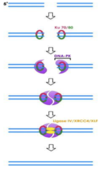L15- DNA repair Flashcards
(65 cards)
DNA integrity can be looked at in 2 ways
- at the level of nucleotdie- mutations
- at the level of chromsosomes (nondisjunction)
if DNA integrity is lost
pathogenic
types of DNA breaks
Single stranded
double stranded
single stranded damage
One strand will remain intact
Not as bad as DS break
double stranded damage
breaking the double strand is very damage

which compoenents of DNA can be dmaaged
all components e.g. bases and sugar phosphate backbone
what causes DNA damage
exogenous and endogenous sources
endogenous causes of DNA damage
error in DNA replication (replication stress)
exogenous sources of DNA damage
Anti-cancer Drugs
Mutagenic chemical - smoking
Alkylation agents
Radiation
Ionising – most comes from radon gas in the ground
Free radicals
what usually happens when healthy DNA becoems damaged
is damaged DNA can be recognised by DNA repair mechanisms which makes the DNA healthy again.
when does m utation occur
when DNA damage is not recognised or repair mechanisms dont work
endogenous sources of single stranded damage
i. Replication stress
ii. Free radicals
exogenous sources of single stranded damage
i. Deamination due to nitrites
ii. UV radiation
exogenous sources of double stranded dmaage
X-ray/Y-ray
definititon of replciation stress
‘Inefficient replication that leads to replication fork slowing, stalling and/ breakage.’
replication stress is an example of
an endogenous source of damage, which causes replication stress
how many factors causes replication stress
3
outline 3 factors which cause replication stress
1) Replication machinery defects
- Misincorporation by DNA polymerase
- Proofreading error by DNA polymerase
2) Replication fork hindrance
- Forward and backward slippage
- e.g. Trinucleotide repeats
3) Defects in response pathway
replication machinery defects
Misincorporation by DNA polymerase
Proofreading error by DNA polymerase
what leads to replciation fork hindrance
repetitive DNA
types of replication fork hindrance
forward slippage
backward slippage
what sort of mutation is forward slippage
deletion mutation








